Do you have a question about the Yamaha YZ450F 2023 and is the answer not in the manual?
Essential safety guidelines and precautions for operating the vehicle.
Identifies the location and purpose of critical labels on the vehicle.
Provides a labeled diagram and description of major vehicle components.
Explains how to locate and use vehicle identification numbers (VIN) and engine serial numbers.
Lists and describes the parts included with the vehicle.
Covers preparation for disassembly and replacement parts recommendations.
Details the function and operation of various instruments and controls.
Guides the user on proper starting procedures and engine break-in.
Outlines key maintenance checks and procedures after the initial break-in period.
Details overall dimensions, wheelbase, weight, and model codes.
Lists detailed engine parameters, including combustion, fuel, oil, cooling, and spark plugs.
Provides specifications for chassis components like wheels, tires, brakes, and suspension.
Details battery specifications, fuses, and voltage/capacity ratings.
Lists standard and specific torque values for various fasteners and components.
Identifies key service parts with part numbers and illustrations for easy ordering.
Provides a detailed schedule for periodic inspections and maintenance tasks.
Outlines essential checks to ensure safe operation before riding the vehicle.
Covers procedures for checking and adjusting engine components like valves and oil.
Guides on inspecting and adjusting chassis parts like brakes, chain, and suspension.
Explains how to check and maintain the battery and fuses for reliable electrical operation.
Covers removal and installation of common chassis parts like seat and covers.
Details the procedures for removing and installing the front wheel.
Details the procedures for removing and installing the rear wheel.
Covers replacing front brake pads and related procedures.
Covers replacing rear brake pads and related procedures.
Details removal, checking, and installation of the handlebar and related controls.
Covers removal, disassembly, checking, assembly, and installation of front fork legs.
Details procedures for removing, checking, and installing the steering head components.
Covers removal and checking of the rear shock absorber assembly.
Details the procedure for removing the swingarm.
Covers removal, checking, and installation of the drive chain and sprockets.
Details installation procedures for the exhaust pipe and muffler.
Covers clutch removal, checking of plates, springs, and assembly.
Details procedures for removing and installing the fuel tank.
Lists and identifies key electrical components of the vehicle.
Explains how to check fuse continuity and replace them if faulty.
Provides instructions for checking battery condition and proper charging procedures.
Provides general guidelines and tips for effective troubleshooting.
Addresses common engine starting and running problems without fault codes.
Helps diagnose and resolve issues related to clutch slippage, drags, and noise.
Guides on troubleshooting difficult shifting, jumping out of gear, and transmission noise.
Addresses overheating problems and noises originating from the cooling system.
Helps diagnose and resolve problems related to disc brake performance.
Addresses symptoms like stiff or soft front/rear suspension and oil leaks.
Diagnoses problems like handlebar wobble, heavy steering, and wheel vibration.
Provides guidance for issues related to the battery not charging.
Covers tuning chassis elements like sprockets and tire pressure for optimal performance.
Details how to adjust front fork settings, including oil amount and spring settings.
Guides on adjusting rear suspension settings, including spring preload and damping.
Provides a key to understand the color coding used in the wiring diagram.
Essential safety guidelines and precautions for operating the vehicle.
Identifies the location and purpose of critical labels on the vehicle.
Provides a labeled diagram and description of major vehicle components.
Explains how to locate and use vehicle identification numbers (VIN) and engine serial numbers.
Lists and describes the parts included with the vehicle.
Covers preparation for disassembly and replacement parts recommendations.
Details the function and operation of various instruments and controls.
Guides the user on proper starting procedures and engine break-in.
Outlines key maintenance checks and procedures after the initial break-in period.
Details overall dimensions, wheelbase, weight, and model codes.
Lists detailed engine parameters, including combustion, fuel, oil, cooling, and spark plugs.
Provides specifications for chassis components like wheels, tires, brakes, and suspension.
Details battery specifications, fuses, and voltage/capacity ratings.
Lists standard and specific torque values for various fasteners and components.
Identifies key service parts with part numbers and illustrations for easy ordering.
Provides a detailed schedule for periodic inspections and maintenance tasks.
Outlines essential checks to ensure safe operation before riding the vehicle.
Covers procedures for checking and adjusting engine components like valves and oil.
Guides on inspecting and adjusting chassis parts like brakes, chain, and suspension.
Explains how to check and maintain the battery and fuses for reliable electrical operation.
Covers removal and installation of common chassis parts like seat and covers.
Details the procedures for removing and installing the front wheel.
Details the procedures for removing and installing the rear wheel.
Covers replacing front brake pads and related procedures.
Covers replacing rear brake pads and related procedures.
Details removal, checking, and installation of the handlebar and related controls.
Covers removal, disassembly, checking, assembly, and installation of front fork legs.
Details procedures for removing, checking, and installing the steering head components.
Covers removal and checking of the rear shock absorber assembly.
Details the procedure for removing the swingarm.
Covers removal, checking, and installation of the drive chain and sprockets.
Details installation procedures for the exhaust pipe and muffler.
Covers clutch removal, checking of plates, springs, and assembly.
Details procedures for removing and installing the fuel tank.
Lists and identifies key electrical components of the vehicle.
Explains how to check fuse continuity and replace them if faulty.
Provides instructions for checking battery condition and proper charging procedures.
Provides general guidelines and tips for effective troubleshooting.
Addresses common engine starting and running problems without fault codes.
Helps diagnose and resolve issues related to clutch slippage, drags, and noise.
Guides on troubleshooting difficult shifting, jumping out of gear, and transmission noise.
Addresses overheating problems and noises originating from the cooling system.
Helps diagnose and resolve problems related to disc brake performance.
Addresses symptoms like stiff or soft front/rear suspension and oil leaks.
Diagnoses problems like handlebar wobble, heavy steering, and wheel vibration.
Provides guidance for issues related to the battery not charging.
Covers tuning chassis elements like sprockets and tire pressure for optimal performance.
Details how to adjust front fork settings, including oil amount and spring settings.
Guides on adjusting rear suspension settings, including spring preload and damping.
Provides a key to understand the color coding used in the wiring diagram.
| Displacement | 449cc |
|---|---|
| Bore x Stroke | 97.0mm x 60.8mm |
| Ignition | TCI: Transistor Controlled Ignition |
| Transmission | 5-speed |
| Final Drive | Chain |
| Rear Suspension | KYB® single shock; fully adjustable, 12.5-in travel |
| Front Brake | Hydraulic disc, 270mm |
| Rear Brake | Hydraulic disc, 240mm |
| Length | 85.6 in |
| Width | 32.5 in |
| Height | 50.4 in |
| Wheelbase | 58.3 in |
| Trail | 4.6 in |
| Ground Clearance | 13.0 in |
| Fuel Capacity | 1.6 gal |
| Engine Type | Liquid-cooled DOHC 4-stroke |
| Fuel System | Mikuni® fuel injection, 44mm |
| Front Suspension | KYB® Speed-Sensitive System, inverted fork; fully adjustable, 12.2-in travel |
| Front Tire | 80/100-21 |
| Rear Tire | 120/80-19 |
| Rake (Caster Angle) | 27.0° |
| Wet Weight | 245 lb |
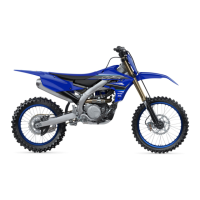
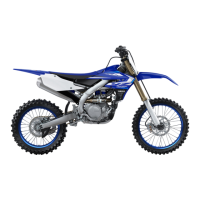



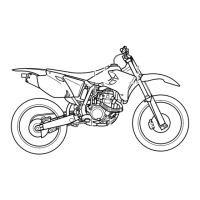

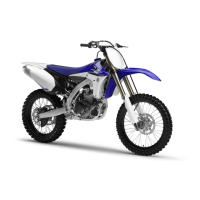



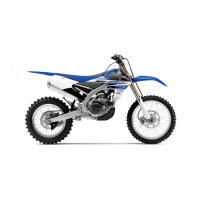
